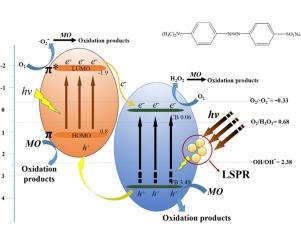【Applied Catalysis B】Fabrication of hollow mesoporous SiO 2-BiOCl@ PANI@ Pd photocatalysts to improve the photocatalytic performance under visible light
作者:Yi Tian, Wei Li, Chenhui Zhao, Yufei Wang, Baoliang Zhang, Qiuyu Zhang
关键字:Hollow mesoporous silica; Hybrid photocatalysts; LSPR; BiOCl; Polyaniline
论文来源:期刊
具体来源:http://www.sciencedirect.com/science/article/pii/S0926337317304265
发表时间:2017年

A facile method was developed to synthesize a series of hollow mesoporous SiO2-BiOCl@PANI@Pd (HBPP) photocatalysts with super adsorption performance, plasmonic effect and fast interfacial charge migration. The samples were characterized by XRD, FETEM, FT-IR, XPS, DRS, etc. Photocatalytic degradation of methyl orange (MO) by HBPP composites was investigated.
Results showed that the photocatalytic property of HBPP composite was superior to that of hollow mesoporous SiO2-BiOCl@PANI (HBP) composite under visible light irradiation, and the HBPP5wt% photocatalyst synthesized under 140 °C exhibits the highest photocatalytic activity. In this photocatalysis system, the orderly mesoporous opening structure of the hollow mesoporous SiO2 sphere could effectively facilitate the transfer of reactant molecules, and the existence of the internal cavities would effectively prolong the action time of the irradiated light for the multiple reflections. Moreover, the formation of interacted interfaces between the semiconductor BiOCl and conducting polymer (polyaniline) could effectively improve the separation of the photogenerated electron-hole pairs, and the palladium nanoparticles (Pd NPs) with strong localized surface plasmon resonance (LSPR) absorption band in the near-UV region could effectively induce the generation of the photoexcited electron-hole pairs in BiOCl, thus the as-obtained photocatalyst exhibits superior photocatalytic activity under visible light irradiation. The work may set foundation for application of the new photocatalyst of HBPP-based LSPR and make an important step forward remedying environmental pollution.